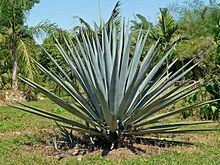
Back باهرة تيكويلانا Arabic باهره تيكويلانا ARZ Agave tequilana AST Синьо агаве Bulgarian আগাভি টেকিলানা Bengali/Bangla Agave tequilana Catalan Agave tequilana CEB Agáve modrá Czech Agave tequilana German Blua agavo Esperanto
| Blue agave | |
|---|---|

| |
| Scientific classification | |
| Kingdom: | Plantae |
| Clade: | Tracheophytes |
| Clade: | Angiosperms |
| Clade: | Monocots |
| Order: | Asparagales |
| Family: | Asparagaceae |
| Subfamily: | Agavoideae |
| Genus: | Agave |
| Species: | A. tequilana
|
| Binomial name | |
| Agave tequilana | |
| Synonyms[1] | |
| |
Agave tequilana, commonly called blue agave (agave azul) or tequila agave, is an agave plant that is an important economic product of Jalisco state of Mexico, due to its role as the base ingredient of tequila, a popular distilled beverage. The high production of agavins (branched oligosaccharides composed mostly of fructose) in the core of the plant is the main characteristic that makes it suitable for the preparation of alcoholic beverages.
The tequila agave is native to the states of Jalisco, Colima, Nayarit, Michoacán, and Aguascalientes in Mexico. The plant favors altitudes of more than 1,500 metres (5,000 ft) and grows in rich and sandy soils. Blue agave plants grow into large succulents, with spiky fleshy leaves, that can reach over 2 metres (7 ft) in height. Blue agaves sprout a stalk (quiote) when they are about five years old. These stalks can grow an additional 5 metres (16 ft), and they are topped with yellow flowers.[2][3] The stalk is cut off from commercial plants so the plant will put more energy into the heart.[4]
The flowers are pollinated by the greater long-nosed bat (and by insects and hummingbirds) and produce several thousand seeds per plant, many of them sterile. The plant then dies. Cultivated plants are reproduced by planting the previously removed shoots; this has led to a considerable loss of genetic diversity in cultivated blue agave.
It is rarely kept as a houseplant, but a 50-year-old blue agave in Boston grew a 9 m (30 ft) stalk requiring a hole in the greenhouse roof and flowered in the summer of 2006.[5]
- ^ "Agave tequilana F.A.C.Weber – The Plant List". www.theplantlist.org.
- ^ Gentry, Howard Scott. Agaves of Continental North America. University of Arizona Press, Tucson, 1992.
- ^ Weber, Frederic Albert Constantin. Bulletin du Muséum d'Histoire Naturelle 8(3): 220–223, f. 1–2. 1902.
- ^ Chadwick, Ian (June 27, 2007). "In Search of the Blue Agave: Harvesting Agave for Tequila". Ianchadwick.com. Retrieved 2011-11-06.
- ^ Agave on Beacon Hill, Boston. WLVI-TV (Television news clip). Archived from the original on 2021-12-21 – via Youtube.